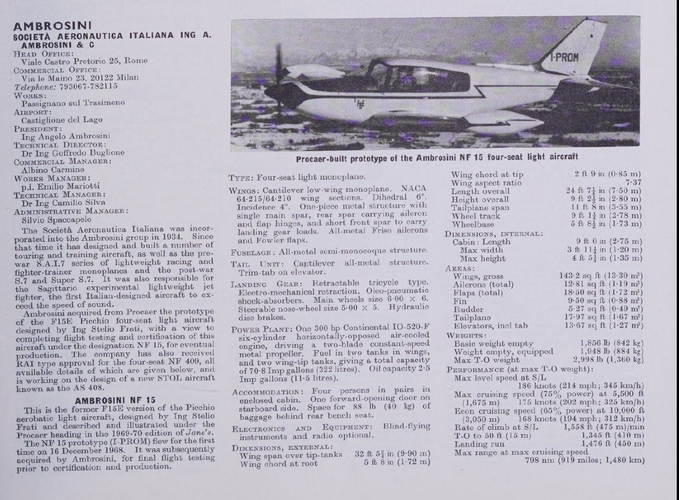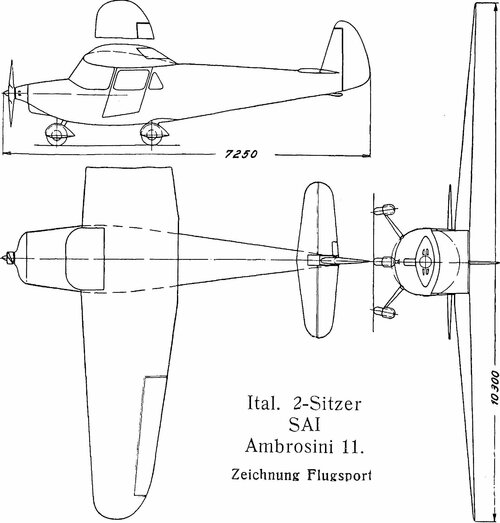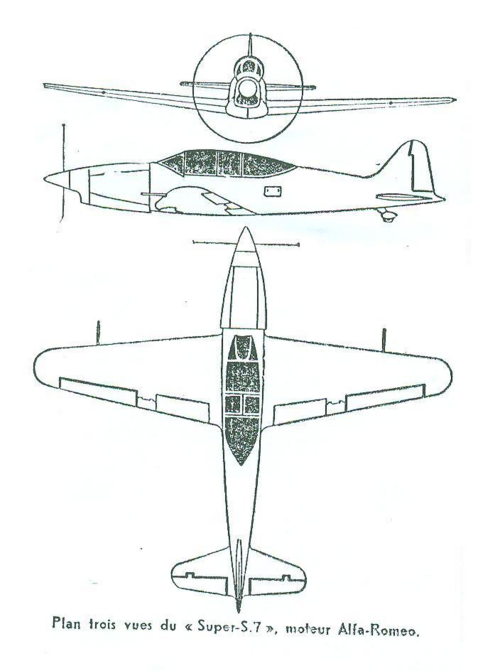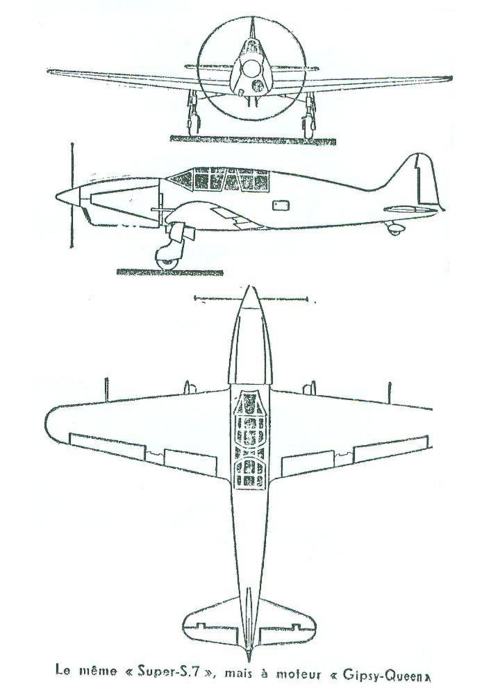- Joined
- 25 July 2007
- Messages
- 4,167
- Reaction score
- 3,835
SAI and SAI Ambrosini Aircraft Designations
I've had a stab at SAI/SAI Ambrosini designations but found little order to them. There are clumps of designation series (which how I have grouped them) but, overall, SAI's approach to designations was rather random.
The Società Aeronautica Italiana (SAI) formed in 1922 (some sources say 1924) with its headquarters in Milan and works at Passignano sul Trasimeno, Perugia. Ing. Antonio Ambrosini was both SAI Chairman and Managing Director (sometimes the firm's name is given as 'Società Aeronautica Italiana, Ing. A. Ambrosini & C.'). SAI adopted a simple 'SAI.x' designation style.
In 1934 SAI was acquired by the Ambrosini group and renamed SAI Ambrosini. The 'SAI.x' designation style was retained but was also confused by arrival of Ing. Sergio Stefanutti as chief designer. Stefanutti, a Regia Aeronautica officer, [1] had served with the Stabilimento Costruzioni Aeronautiche (SCA) at Guidonia where he designed a range of experimental canard aircraft (which are listed separately, along with later Stefanutti designs for the Stabilimento Costruzioni Aeronautiche with 'SCA.x' designations).
One Stefanutti canard design was built by SAI Ambrosini resulting in the abberant designation SS.4 within the 'SAI.x" numbering sequence.
AFAIK, the SAI.11 parasol monoplane was the last of the 'SS.x' designation series. For some reason, a 1940 S.7 development was designated SAI.107 beginning a new 'SAI.xxx' designation series. The use of the 'S' prefix continued out of habit - even in official publications. Eg:
"Stipa "Velivolo da caccia S.A.I. Ambrosini S 404. Motore IF Zeta" Con relazione della Direzione superiore degli Studi e delle Esperienze." [2]
The 'SAI.xxx' sequence continued until the end of WW2. Hesham claims that SAI Ambrosini had a '400 series' after WW2 running from the SAI-407 to the Frati-designed NF-409 (related to the Frati F.15). Alas, I have not been able to confirm either designation (the only '409' I could find connected to Stelio Frati was the SS 409 drone of 1975).
After the war, another new designation series began the 'S.x" sequence - with S.7 applied to SAI.7 developments. Then, for no obvious reason, designations jump to a 4-digit 'S.1xxx' sequence beginning with the S.1001 Grifo. After the S.1003 project, use of designations seems to lapse. Late SAI Ambrosini designs were given names - eg: Sagittario, Vindex - but if they had designations, I am not aware of them.
There were also 'P' designations ... although whether these were 'P' for Progetto or for the designer Ermenegildo Preti, I am not sure. Perhaps both. Most such designations are in the 'P.xxx' range. However, the P.18 jet trainer project of 1954 plus the P.25 and P.70 engines were certainly Ing. Preti designs.
There are also a few 'widow' designations ... the 1959 XS.1 twin-jet interceptor study (a Stefanutti design but I'm not entirely sure of SAI Ambrosini's involvement); the 1975 SS 409 armed recce drone study; and the modern G97 Spotter.
AFAIK, SAI Ambrosini never applied its own designations to licensed designs - eg: Breda Ba.25, Macchi C.200, CVV-6 Canguro - or the products of outside designers - eg: Stelio Frati's F.4 and F.7 Rondone light planes built in small numbers in collaboration with Aeronautica Lombardi.
Another Aeronautica Lombardi product often associated with SAI Ambrosini is the AL.12P. Wikipedia claims that this 1942 transport glider was designed by 'A. Ambrosini'. AFAIK, Angelo Ambrosini had no involvement. The AL.12P was designed by Stefanutti, Ermenegildo Preti, and Stelio Frati. The gliders were built by Aeronautica Lombarda - hence the 'AL'. I include it here for completeness:
A.R. - 1943 Assalto Radioguidato single-engined flying bomb, x 5
- A.R.: 1 x 1,000 h.p. Fiat A.80 18-cyl, span 17 m, MM.75576
- Aeroplani-Progetti prototipi speciali: Mistel-style vers.
-- http://www.secretprojects.co.uk/forum/index.php/topic,1260.msg10142.html
-- http://www.alieuomini.it/files/anteprima/medium/aeronautica_lombarda_assalto_radioguidato,3274.jpg
Postwar Aerfer designs are also attributed to SAI Ambrosini. This seems to be a hangover from the AMI's order for SAI Ambrosini to transfer the Sagittarius II fighter design to Aerfer for further development. Stefanutti being employed as a consultant by AERFER likely further confused researchers.
By 1960, SAI Ambrosini had closed the last of its aviation-related activities - a flying school - and turned to boat-building. I presume that the modern boat-building firm, SAI Ambrosini Marine/Divisione Nautica della SAI Ambrosini is connection with the original firm (although it is not located in the same production space).
_______________________________________________________________
[1] Upon his graduation in aeronautical engineering in 1931, Stefanutti joined the Regia Aeronautica and was assigned to the Direzione delle costruzioni del Ministero dell'Aeronautica.
[2] To add further confusion, this quote connects Luigi Stipa to this 'S 404' fighter while Skybolt has attributed the design of the SAI.404 to Ing. Rossi, chief of the SAI Ambrosini technical office.
_______________________________________________________________
I've had a stab at SAI/SAI Ambrosini designations but found little order to them. There are clumps of designation series (which how I have grouped them) but, overall, SAI's approach to designations was rather random.
The Società Aeronautica Italiana (SAI) formed in 1922 (some sources say 1924) with its headquarters in Milan and works at Passignano sul Trasimeno, Perugia. Ing. Antonio Ambrosini was both SAI Chairman and Managing Director (sometimes the firm's name is given as 'Società Aeronautica Italiana, Ing. A. Ambrosini & C.'). SAI adopted a simple 'SAI.x' designation style.
In 1934 SAI was acquired by the Ambrosini group and renamed SAI Ambrosini. The 'SAI.x' designation style was retained but was also confused by arrival of Ing. Sergio Stefanutti as chief designer. Stefanutti, a Regia Aeronautica officer, [1] had served with the Stabilimento Costruzioni Aeronautiche (SCA) at Guidonia where he designed a range of experimental canard aircraft (which are listed separately, along with later Stefanutti designs for the Stabilimento Costruzioni Aeronautiche with 'SCA.x' designations).
One Stefanutti canard design was built by SAI Ambrosini resulting in the abberant designation SS.4 within the 'SAI.x" numbering sequence.
AFAIK, the SAI.11 parasol monoplane was the last of the 'SS.x' designation series. For some reason, a 1940 S.7 development was designated SAI.107 beginning a new 'SAI.xxx' designation series. The use of the 'S' prefix continued out of habit - even in official publications. Eg:
"Stipa "Velivolo da caccia S.A.I. Ambrosini S 404. Motore IF Zeta" Con relazione della Direzione superiore degli Studi e delle Esperienze." [2]
The 'SAI.xxx' sequence continued until the end of WW2. Hesham claims that SAI Ambrosini had a '400 series' after WW2 running from the SAI-407 to the Frati-designed NF-409 (related to the Frati F.15). Alas, I have not been able to confirm either designation (the only '409' I could find connected to Stelio Frati was the SS 409 drone of 1975).
After the war, another new designation series began the 'S.x" sequence - with S.7 applied to SAI.7 developments. Then, for no obvious reason, designations jump to a 4-digit 'S.1xxx' sequence beginning with the S.1001 Grifo. After the S.1003 project, use of designations seems to lapse. Late SAI Ambrosini designs were given names - eg: Sagittario, Vindex - but if they had designations, I am not aware of them.
There were also 'P' designations ... although whether these were 'P' for Progetto or for the designer Ermenegildo Preti, I am not sure. Perhaps both. Most such designations are in the 'P.xxx' range. However, the P.18 jet trainer project of 1954 plus the P.25 and P.70 engines were certainly Ing. Preti designs.
There are also a few 'widow' designations ... the 1959 XS.1 twin-jet interceptor study (a Stefanutti design but I'm not entirely sure of SAI Ambrosini's involvement); the 1975 SS 409 armed recce drone study; and the modern G97 Spotter.
AFAIK, SAI Ambrosini never applied its own designations to licensed designs - eg: Breda Ba.25, Macchi C.200, CVV-6 Canguro - or the products of outside designers - eg: Stelio Frati's F.4 and F.7 Rondone light planes built in small numbers in collaboration with Aeronautica Lombardi.
Another Aeronautica Lombardi product often associated with SAI Ambrosini is the AL.12P. Wikipedia claims that this 1942 transport glider was designed by 'A. Ambrosini'. AFAIK, Angelo Ambrosini had no involvement. The AL.12P was designed by Stefanutti, Ermenegildo Preti, and Stelio Frati. The gliders were built by Aeronautica Lombarda - hence the 'AL'. I include it here for completeness:
A.R. - 1943 Assalto Radioguidato single-engined flying bomb, x 5
- A.R.: 1 x 1,000 h.p. Fiat A.80 18-cyl, span 17 m, MM.75576
- Aeroplani-Progetti prototipi speciali: Mistel-style vers.
-- http://www.secretprojects.co.uk/forum/index.php/topic,1260.msg10142.html
-- http://www.alieuomini.it/files/anteprima/medium/aeronautica_lombarda_assalto_radioguidato,3274.jpg
Postwar Aerfer designs are also attributed to SAI Ambrosini. This seems to be a hangover from the AMI's order for SAI Ambrosini to transfer the Sagittarius II fighter design to Aerfer for further development. Stefanutti being employed as a consultant by AERFER likely further confused researchers.
By 1960, SAI Ambrosini had closed the last of its aviation-related activities - a flying school - and turned to boat-building. I presume that the modern boat-building firm, SAI Ambrosini Marine/Divisione Nautica della SAI Ambrosini is connection with the original firm (although it is not located in the same production space).
_______________________________________________________________
[1] Upon his graduation in aeronautical engineering in 1931, Stefanutti joined the Regia Aeronautica and was assigned to the Direzione delle costruzioni del Ministero dell'Aeronautica.
[2] To add further confusion, this quote connects Luigi Stipa to this 'S 404' fighter while Skybolt has attributed the design of the SAI.404 to Ing. Rossi, chief of the SAI Ambrosini technical office.
_______________________________________________________________






